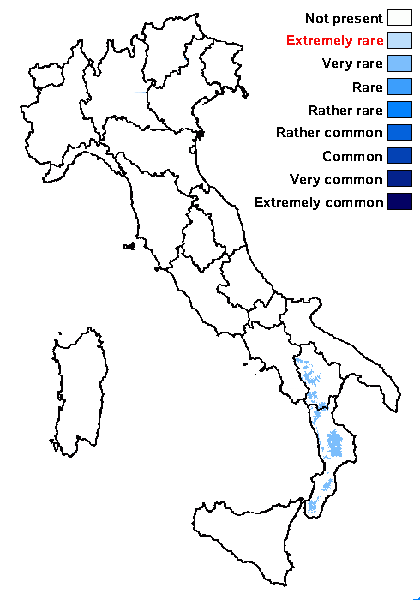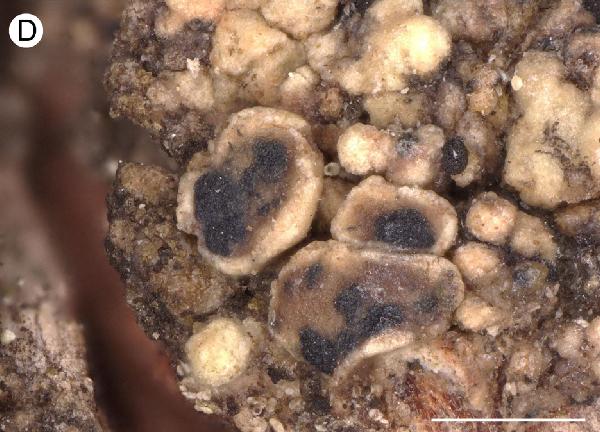Arthonia caerulescens (Almq.) R. Sant.
Flora, Regensburg 64, 21: 324, 1881.. Basionym: Arthonia apotheciorum subsp. caerulescens Almq. - K. svenska Vetensk-Akad. Handl., ny följd, 17, 6: 59, 1880.
Synonyms:
Distribution: S - Bas (Brackel & Puntillo 2023), Cal (Brackel & Puntillo 2023).
Description: Thallus inapparent, not lichenized, the hyphae developing inside the apothecia of Lecanora varia and related species. Apothecia arthonioid, black, rounded, 0.1-0.4 mm across, appearing as small, black dots on the apothecia of the host, then blackening the whole surface, Epithecium dark blue-green or brown with an olive tinge; hymenium 40-50 μm high, I+ blue; paraphysoids 1.5-2 μm thick at mid level, the apical cells with dark pigmented caps, 2-4 μm wide; hypothecium colourless to very pale brown. Asci 8-spored, broadly clavate to subglobose, semi-fissitunicate, with a large, non-amyloid apical dome, and a distinct ocular chamber, Arthonia-type. Ascospores 1-septate, slightly constricted at septum, hyaline, 10-12 x 4-6 µm. Photobiont absent. Spot tests: K-, C-, KC-, P-. Chemistry: without lichen substances. Note: a lichenicolous fungus growing in the apothecia of Lecanora varia and related species; known among others from Spain, France, North Macedonia and Montenegro.
Growth form: Lichenicolous fungus
Substrata: lignum
Reproductive strategy: mainly sexual
paras Lecanora varia
Commonnes-rarity: (info)
Alpine belt: absent
Subalpine belt: very rare
Oromediterranean belt: absent
Montane belt: very rare
Submediterranean belt: absent
Padanian area: absent
Humid submediterranean belt: absent
Humid mediterranean belt: absent
Dry mediterranean belt: absent

Predictive model
Herbarium samples

Source: Hafellner J, Grube M. Arthonia epipolytropa and Arthonia subclemens, two new lichenicolous species on Lecanora polytropa, with a key to the microfungi known on this common species. The Lichenologist. 2023;55(5):241-251. doi:10.1017/S0024282923000397 - CC BY 4.0
Arthonia caerulescens (Mayrhofer 641); habitus. Scale: 0.5 mm.
Growth form: Lichenicolous fungus
Substrata: lignum
Reproductive strategy: mainly sexual
paras Lecanora varia
Commonnes-rarity: (info)
Alpine belt: absent
Subalpine belt: very rare
Oromediterranean belt: absent
Montane belt: very rare
Submediterranean belt: absent
Padanian area: absent
Humid submediterranean belt: absent
Humid mediterranean belt: absent
Dry mediterranean belt: absent

Predictive model
| Herbarium samples |

 INDEX FUNGORUM
INDEX FUNGORUM
 GBIF
GBIF

